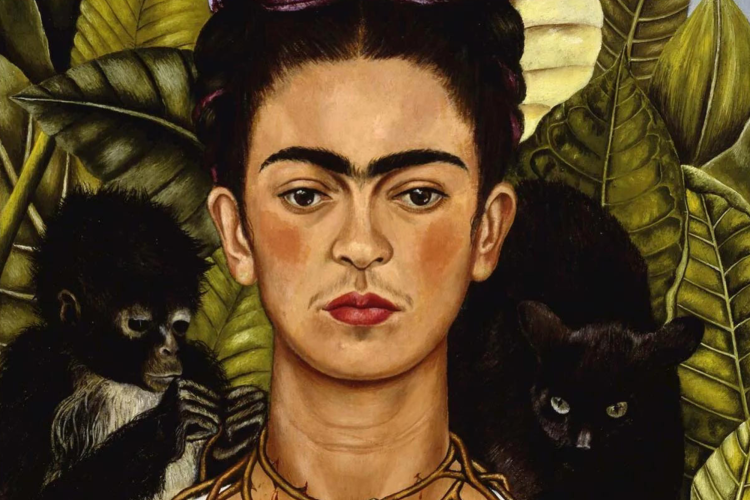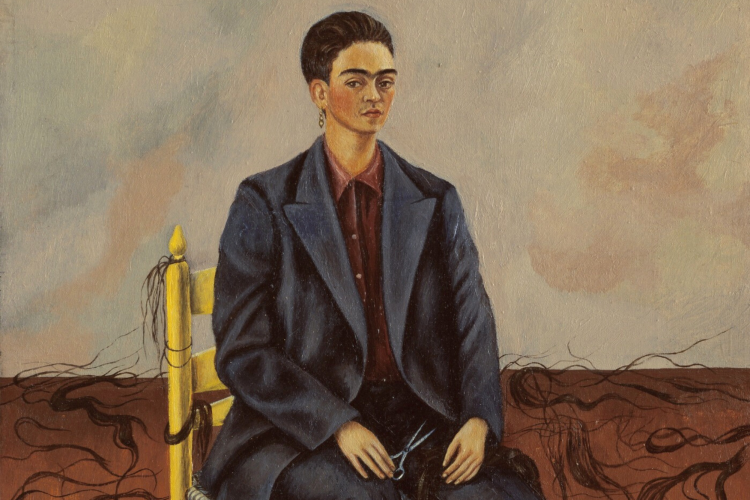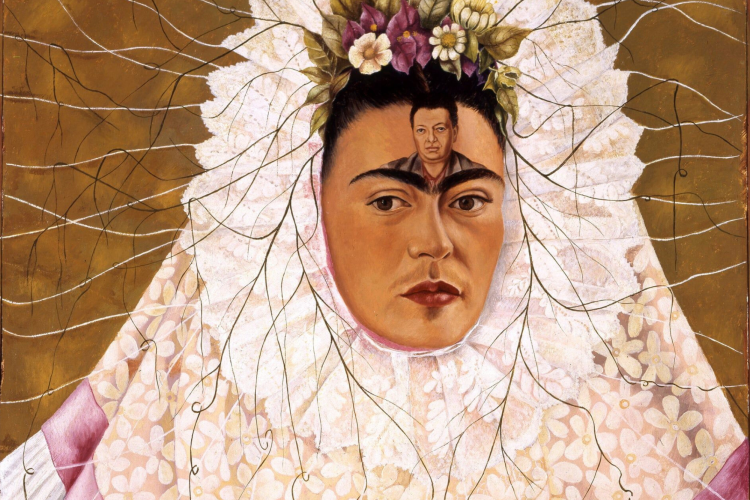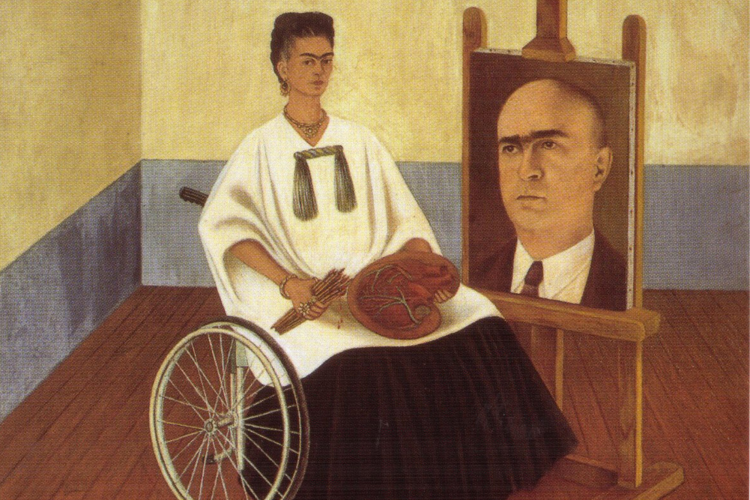17 Frida Kahlo Paintings You Should Know in 2025

Frida Kahlo paintings are so famous that critics have coined the phrase, “Fridamania.” And it makes sense. Frida Kahlo paintings are just as revolutionary today as they were throughout the 1930s, 40s and 50s. While she achieved some success during her lifetime, her posthumous legacy has been even more triumphant.
Along with the Warhol paintings and the Pollock paintings of the 20th century, Frida Kahlo paintings are cherished and revered by millions, making her one of the most famous painters. In an era where others were so quick to categorize the works of independent artists as impressionist paintings, surreal paintings, and so on, Kahlo’s brutal, but honest portrayal of selfhood solidified her legacy as an artist to transcend labels.
So if you're asking, what is one of Frida Kahlo's famous paintings? This list will share 17 Frida Kahlo paintings you have to see.
Jump to Section
Why Is Frida Kahlo Famous?
Frida Kahlo’s life was riddled with art, loss, pain and self-examination. She explored her relationship to suffering through visual symbolism, gifting the world works of art that can only be described as poignant reflections of both her turmoil and resilience. So, what was special about Frida Kahlo’s paintings?
Often taking the shape of complex self-portraits, Frida Kahlo paintings developed a space for future generations of women in the art industry. In a world where women were meant to be simple, Frida Kahlo paintings defied convention, displaying the depths of women’s experiences.
Frida Kahlo paintings often incorporate elements of Mexican folk art like vibrant colors reminiscent of traditional Mexican textiles and symbolic images depicting indigenous Mexican folklore. Whereas works like Georgia O'Keefe paintings portray symbolism through the Mexican landscape and nature. Many of her paintings were done using oil paints on canvas.
But no matter where you stand on the acrylic vs. oil paint debate, studying Frida Kahlo paintings is a great place to start if you’re looking for acrylic painting ideas for beginners, oil painting for beginners or simply painting for beginners.
Where are Frida Kahlo’s original paintings? All over the world. Frida Kahlo's paintings are held at The Museum of Modern Art in New York, the Los Angeles County Museum of Art, the de Young Museum in San Francisco and the National Museum of Women in the Art in Washington, D.C., to name a few.
Most notably, you can check out a few Frida Kahlo paintings at her own home, which was opened to the public in 1958 as La Casa Azul, ‘The Blue House,’ after the painter's death.

How Did Frida Kahlo Die?
Due to her lifelong struggles, it’s hard to avoid the question, how did Frida Kahlo die? The official report states that Kahlo died on July 13, 1954, at the age of 47 after suffering a pulmonary embolism. However, it is speculated that after decades of suffering from chronic pain she may have overdosed or died of intentional poisoning.
This relationship to physical pain is portrayed in many Frida Kahlo paintings. After suffering from polio as a child, she was involved in a bus incident when she was 18 years old. Kahlo was left with fractures in her spine and elsewhere that left her in severe pain for the remainder of her life.
In fact, it was after this initial incident that she began her collection of Frida Kahlo paintings, using art as a way to cope while she was stuck at home recovering. In and out of surgeries for the rest of life, painting became a practice of understanding.
Frida Kahlo paintings and meanings take shape as the events of her life unfold. That’s why this list will examine Frida Kahlo paintings in order to better understand Kahlo’s tapestry of self-expression.
Frida Kahlo's Greatest Paintings
1. Self-Portrait Wearing a Velvet Dress (1926)
Experiencing a Frida Kahlo self-portrait is an intimate moment due to the inherent vulnerability of her works. Kahlo produced ‘Self-Portrait Wearing a Velvet Dress’ at the young age of 19, making it one of her earliest pieces.
Frida is pictured in a velvet dress with a composed expression, which is notably significant considering the tumultuous events leading up to the painting: a bus accident that left her in severe pain and a relationship with her then boyfriend that was anything but healthy.
Perhaps the swirling, dark waves that engulf the background of this Frida Kahlo painting are a visual metaphor for the pain she felt the need to persevere through during this period of her life.
As one of the earliest Frida Kahlo paintings, it also conjures up the question, how many paintings by Frida Kahlo are there? For such an iconic artist, the answer is surprisingly low. According to the Smithsonian Magazine, she only produced around 200 paintings in her lifetime.

2. Frida and Diego Rivera (1931)
An important character in the book of Frida Kahlo’s life is David Rivera. The two were first married from 1929-1939 and then again from 1940-1954. Rivera played a much more significant role in Kahlo’s life than the ex that inspired ‘Self-Portrait Wearing a Velvet Dress’, and this new relationship would turn out to be equally rocky.
In 1931, Kahlo was navigating her new identity as a wife while also navigating her identity as an artist. In this Frida Kahlo painting, ‘Frida and Diego Rivera’, she is seen standing next to Rivera, holding his hand. In his other hand, Rivera holds a painter’s pallet because he, too, was a painter.
Kahlo is depicted in a traditional Mexican dress while Rivera is pictured in a more modern suit. The baron background draws attention to the two characters who seem drastically different from one another.
This Frida Kahlo painting portrays a significant growth in her painting techniques evident in the intricate details of her dress, the lines on Rivera's face and the contrast of colors.
3. Henry Ford Hospital (1932)
After experiencing a miscarriage, Kahlo turned to the canvas. This Frida Kahlo painting, ‘Henry Ford Hospital’, depicts Kahlo in a hospital bed surrounded by various floating images that each represent the loss of her child and her longing to be a mother.
This Frida Kahlo painting is a perfect example of the artist’s use of realism and surrealism, although Kahlo often denounced the latter. According to the Museum of Modern Art, the artist rejected the notion that she was a surrealist. “I never painted dreams," she said. "I painted my own reality."
4. My Birth (1932)
Around the time of this Frida Kahlo painting, Kahlo was coping with her miscarriage while now also recovering from the loss of her mother. In ‘My Birth’, a woman is depicted on a bed with a sheet covering her face, giving birth to a baby who Frida identified as herself.
A traditional religious painting of Latin America called a "retablo" hangs above the bed. Kahlo utilized a frontal perspective, forcing the viewer into the immediacy of the scene.
5. My Grandparents, My Parents and I (1936)
Many people view Kahlo's 1936 painting ‘My Grandparents, My Parents and I’ as a visual autobiography.
This Frida Kahlo painting portrays a family tree with a young Kahlo at the center. Red lines representing bloodlines connect Kahlo to her parents and her grandparents. The background depicts both European and Mexican landscapes calling attention to Kahlo's mixed heritage.

6. The Frame (1938)
‘The Frame’ by Frida Kahlo portrays a self-portrait of Kahlo from the shoulder up. She gazes directly at the viewer and is framed by a border that incorporates motifs of traditional Mexican folk art.
This Frida Kahlo painting was part of her first solo exhibition in New York and it was also the first work by a 20th-century Mexican artist to be purchased by the Louvre Museum.
7. Girl with Death Mask (1938)
‘Girl with Death Mask’ is a chilling exploration of mortality and innocence and perhaps one of the most haunting Frida Kahlo paintings. A young girl is surrounded by a desolate landscape.
She stands, alone, wearing a traditional mask worn during Day of the Dead celebrations known as a death mask. Another mask that resembles a bloody-mouthed tiger lies at her right side. This painting accompanied ‘The Frame’ in Kahlo's first solo exhibition and helped to further establish her international reputation.
8. The Two Fridas (1939)
‘The Two Fridas’ is arguably one of the most recognized Frida Kahlo paintings. Kahlo depicts herself twice in ‘The Two Fridas’, both characters standing next to each other. The Frida on the left is wearing a white Victorian dress, which represents her German heritage, and her heart is open and bleeding.
The Frida on the right is wearing a traditional Tehuana dress, which represents her Mexican identity, and her heart is intact. A dark and stormy sky rages on in the background.
9. Self-Portrait with Cropped Hair (1940)
In ‘Self-Portrait with Cropped Hair’, Kahlo is seated in a chair with hair littered on the ground around her. Her hair is short, and she is wearing an oversized men's suit, holding a pair of scissors.
This Frida Kahlo self-portrait was produced in the year between Kahlo and Rivera's first divorce and remarriage. ‘Self-Portrait with Cropped Hair’ is often interpreted as a commentary on the superficial aspects and standards that often-defined women's relationships in the 20th-century like hair or clothes.

10. Self-Portrait with Thorn Necklace and Hummingbird (1940)
In ‘Self-Portrait with Thorn Necklace and Hummingbird’ we yet again find Kahlo with an intense and steadfast gaze that seems peculiar considering the predicament in which she painted herself in.
A black hummingbird hangs from a necklace made of thorns. The thorns pierce through Kahlo's neck as a spider monkey pulls at the necklace, causing her to bleed.
11. Me and My Parrots (1941)
‘Me and My Parrots’ is a vibrant and colorful Frida Kahlo painting. Kahlo is portrayed seated with four parrots perched on her in various places, almost framing her face. She wears a traditional Mexican blouse, white and puffed at the sleeves.
She looks directly at the viewer with another poised gaze. Many critics compliment the realistic nature of this Frida Kahlo painting, pointing out the details of the birds' wings and the rouge added to her cheeks.
12. Self Portrait with Braid (1941)
This Frida Kahlo painting is an extension of one of her earlier works. The hair that was chopped off in ‘Self-Portrait with Cropped Hair’ appears again in ‘Self-Portrait with Braid’. However, this time the hair is fashioned in a looping braid on top of Kahlo's head.
The artist's naked upper body is covered in large green leaves and some kind of locking mechanism is fashioned around her neck. The background is devoid of color.
13. Self-Portrait as a Tehuana (1943)
The Tehuana dress is an enduring symbol of Kahlo's identity that reappears countless times throughout her career. And in ‘Self-Portrait as a Tehuana’, the traditional indigenous dress from the Tehuantepec region truly shines.
Kahlo is depicted wearing an elaborate, white headpiece called a "resplandor," a symbol of devotion and purity. Her then husband Riviera is pictured on her forehead, above her dark eyebrows.

14. Without Hope (1945)
‘Without Hope’ by Frida Kahlo reflects the physical and emotional turmoil the artist suffered throughout her life. The background is a baron gray scene. In this desolate region, Kahlo lies in a bed with the sheets pulled up to her shoulders.
Above her, organs, fish and other grotesque materials are funneled into her mouth. Many connect this piece to Kahlo’s years of surgeries. During her many recoveries, Kahlo was often forced to eat blended foods as she could not eat solids.
15. The Wounded Deer (1946)
Another Frida Kahlo painting that deeply portrays the artist’s physical and emotional pain is ‘The Wounded Deer’.
This Frida Kahlo painting depicts Kahlo with the body of a deer wounded by nine arrows that pierce through her body, blood dripping from the deep wounds. The landscape is dark and heavily forested with a single broken branch on the ground beneath her hooves.
16. Weeping Coconuts (1951)
‘Weeping Coconuts’ seems to be a lesser-known installment of the artist’s works, so you might not find it with the other Frida Kahlo paintings for sale. And if that’s what you’re looking for, be prepared. Frida Kahlo paintings auction for millions.
But don’t worry, you can get your hands on a Frida print for as low as $10. ‘Weeping Coconuts’ illustrates two coconuts, one of which has tears coming from its holes, making the fruit seem more human-like.
17. Self-Portrait with Portrait of Dr. Farill (1951)
‘Self-Portrait with Portrait of Dr. Farill’ is one of Frida Kahlo’s last works before she passed away in 1959. In fact, it was her last signed self-portrait before she died. In the painting, Kahlo sits in a wheelchair, holding her painting supplies: in one hand, paint brushes and in the other, a palette in the shape of an anatomically correct heart.
In front of her on an isle is a portrait of Dr. Farill, the same surgeon who performed seven surgeries on her spine in 1951.

Frida Kahlo has gone down in history as one of the most authentic artists to grace this earth with her beautiful yet harsh depictions of herself and the various elements that added meaning – for good and for bad – to her life.
She is a fascinating character to explore, and her work is equally intriguing. She was a cultural icon who did not fear vulnerability and she will forever be admired for her strength, resilience, independence and expression.
For even more fun painting ideas, check out other experiences happening on Classpop!


